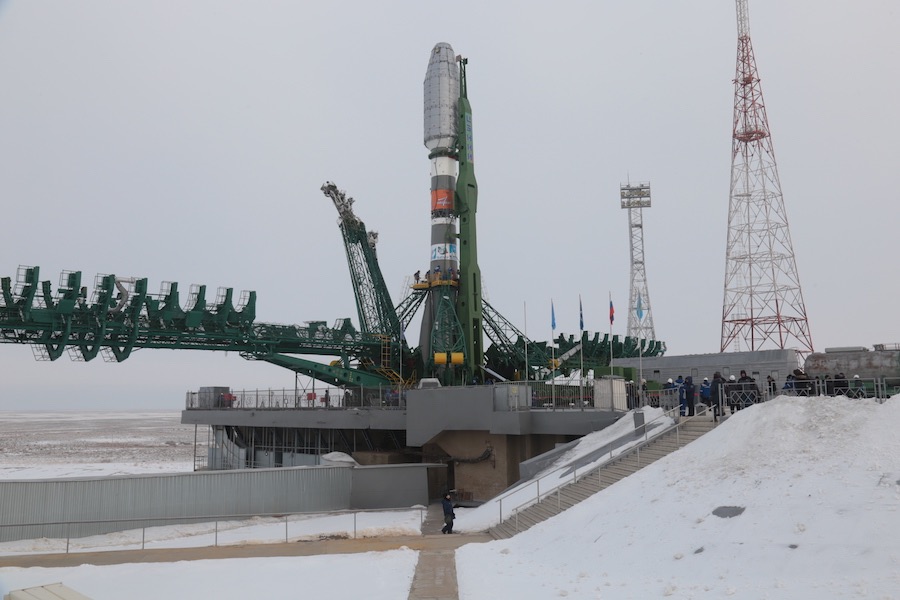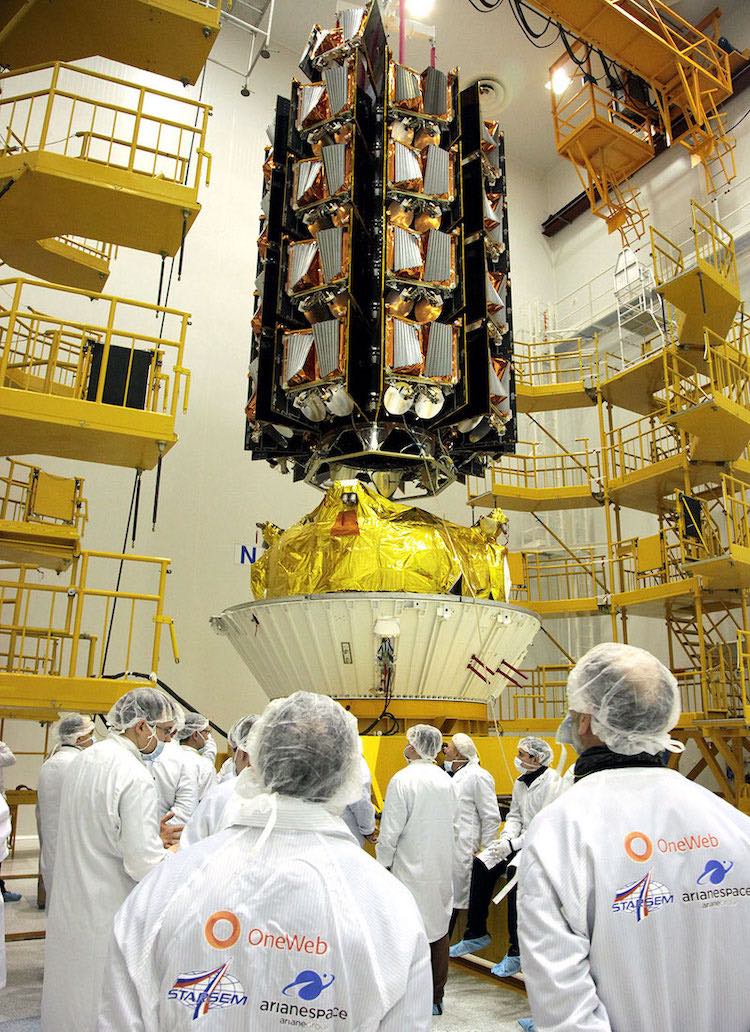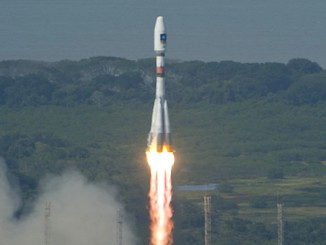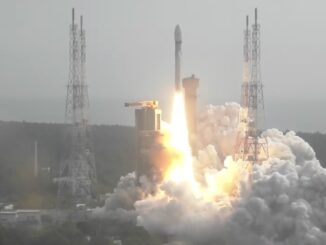
The first 34 satellites manufactured on a new commercial spacecraft assembly line just outside the gates of the Kennedy Space Center in Florida are scheduled for liftoff on a Soyuz rocket Thursday halfway around the world in Kazakhstan, kicking off a sequence of up to 20 launches from three countries to deploy nearly 650 satellites for OneWeb’s global Internet network.
Stacked on a dispenser inside the payload shroud of a Soyuz-2.1b booster, the 34 OneWeb satellites will rocket into orbit at 2142:41 GMT (4:42:41 p.m. EST) Thursday from the Complex 31 launch site at the Baikonur Cosmodrome in Kazakhstan.
Liftoff is timed for 2:42:41 a.m. local time Friday at the Baikonur Cosmodrome.
It’s the first of around 20 launches planned over the next two years, each booked through French launch services provider Arianespace with 32 to 36 satellites on-board, to build out the first phase of the OneWeb constellation.
London-based OneWeb says its network will be ready for limited services later this year, and full global connectivity in 2021.
OneWeb Satellites, a joint venture between OneWeb and Airbus Defense and Space, builds the spacecraft for OneWeb in a factory that opened last year at Exploration Park, Florida, just outside the gates of NASA’s Kennedy Space Center.
Tony Gingiss, CEO of OneWeb Satellites, said he is pleased with the startup of the new factory.
The 105,500-square-foot (9,800-square-meter) factory has two assembly lines with stations where technicians integrate panels, antennas, propulsion systems, solar arrays and other satellite components, known as modules. The facility has a U-shaped layout, with kits of satellite components arriving from suppliers on one end, and complete spacecraft — already fueled with xenon propellant — rolling out the other side before shipment to faraway launch sites.
Robots on the factory floor help move satellites and piece panels from station to station, install batteries and attach thermal blankets to the spacecraft. Gingiss hopes to add more automation to the factory in the future.
“That’s a two-week journey, roughly, from parts in on one end to fully-tested satellites integrated on rails going out the other end,” Gingiss said.
OneWeb Satellites marked the grand opening of the new factory last July, then began moving in tooling and commissioning the factory to make it ready for producing satellite hardware.
“We started that in the summertime, and then we ramped up one (assembly) line at a time, and then we started to bring up — in some cases — redundant lines,” Gingiss said. “Right now, we have two lines of everything except solar arrays, which we produce pretty quickly so we don’t need two lines. And we’ve ramped up those basically from the summertime of last year all the way until now, and produced our first batch of 34 (satellites) in the December timeframe and shipped them out in January.”
OneWeb Satellites aims to manufacture two of the mini-fridge-sized satellites per day, with one 325-pound (147.5-kilogram) spacecraft rolling off each of the factory’s two assembly lines.
During production of the first batch of OneWeb satellites, which shipped from Florida to Kazakhstan on two Antonov cargo jets in December and January, Gingiss said the processing time for each spacecraft decreased after completion of the first few units.
“There were some modules that exceeded our expectations, and we were seeing integration times much better than we actually thought we would see that early in production,” Gingiss said. “Certainly, the (communications) payload, which is more complicated, followed more our expected learning curve, where the first few took a significant amount longer, two or three times what we ultimately will get to.
“We always said it would probably be a six-month ramp-up,” Gingiss told Spaceflight Now during a recent visit to the OneWeb Satellites factory. “I think we’re well ahead of that, but we are not down to what I would call one-shift, five-day operations. We’re still working multiple shifts. There have been weeks where we’ve worked seven days on the first batch, but we’re seeing it come down as we would expect, and I’m very happy with the performance of the team.
“I think we’re right where we need to be to sustain these rates all the way through the production,” Gingiss said. “My goal now is to figure out how to do batch 2, and do the exact same thing with less effort, and that’s going to be the goal every subsequent batch.”
Gingiss said his team is scheduled to have the next batch OneWeb satellites ready for shipment to the Baikonur Cosmodrome in mid-February, ahead of a launch on another Soyuz flight in March.

The OneWeb satellites leave the Florida factory on special rail fittings, which allow crews at the launch site to quickly mate the spacecraft four at a time to a cylindrical black dispenser made by RUAG Space, a Swiss space structures supplier. The spacecraft also leave the factory fully fueled with non-toxic xenon propellant for the satellites’ plasma thrusters.
The launch this week will mark the first mission with a full load of OneWeb satellites. A Soyuz launch in February 2019 from French Guiana carried six demonstration satellites into orbit, and OneWeb says all six have performed well.
The six demonstration spacecraft were built by OneWeb Satellites at an Airbus facility in Toulouse, France, while the 34 satellites awaiting liftoff Thursday were the first produced in Florida.
OneWeb announced late last year the first full-up launch would be delayed from December into early 2020 to allow extra time to perform additional tests on the Ku-band satellites.
Once the OneWeb satellites arrived at Baikonur, the launch campaign proceeded on pace for liftoff Feb. 6.
Ground teams attached the satellites four-at-a-time in eight columns around the circumference of the RUAG Space dispenser, then added two more to the top of the structure. Technicians mated the dispenser to a Fregat upper stage, then encapsulated the entire package inside the Soyuz nose shroud before connecting the payload composite to the Soyuz-2.1b booster.
The Soyuz rocket rolled out to the Complex 31 launch pad Monday and was raised vertical for final launch preparations.
Russian teams will load kerosene and liquid oxygen propellants into the three-stage Soyuz-2.1b rocket in the final hours before liftoff.
The Soyuz rocket will blast off and head north from Baikonur, flying over Kazakh and Russian territory as it jettisons four first stage boosters, its core stage and payload fairing. The Soyuz third stage will release the Fregat upper stage with the 34 OneWeb satellites on a suborbital trajectory around nine minutes after liftoff.
The Fregat stage will fire its engine to place the OneWeb payloads in a parking orbit around 14 minutes into the mission, then reignite its engine around 67 minutes after liftoff to reach a circular orbit 280 miles (450 kilometers) above Earth, with an inclination of 87.4 degrees to the equator.
The dispenser will release the two top-mounted OneWeb spacecraft 71 minutes after liftoff, then the Fregat upper stage will fire its small control thrusters to maneuver to a slightly different position before deployment of the remaining 32 satellites in groups of four.
The OneWeb deployments will occur at intervals of approximately 20 minutes, with further firings of the Fregat’s fine maneuvering thrusters in between each separation event.
The last four OneWeb satellites will separate from the carrier module 3 hours, 45 minutes after liftoff — at 0127 GMT on Feb. 7 (8:27 p.m. EST on Feb. 6) — followed by a deorbit burn by the Fregat upper stage to burn up in the atmosphere, ensuring the spent rocket does not create unnecessary space debris.

The OneWeb satellites, each designed for a five-year lifetime, will extend their power-generating solar panels and activate their xenon plasma propulsion systems to begin post-launch checkouts. Each satellite will use its xenon thruster to reach an operational orbit at an altitude of 745 miles (1,200 kilometers), where the OneWeb network will spread an initial block of 648 satellites among multiple orbital planes.
OneWeb scaled back the size of its first-generation satellite network in 2018 after finding that the first spacecraft built for the constellation performed better than expected.
But OneWeb has ambitions to grow its broadband fleet to 1,980 satellites to meet higher demand.
Founded by Greg Wyler, a satellite and telecom entrepreneur, OneWeb announced last year that it demonstrated live HD video streaming through the company’s first six satellites. OneWeb and Iridium, which operates a low Earth orbit network with 66 cross-linked L-band communications and data relay satellites, announced an agreement in September to work toward a combined service offering.
OneWeb is in heated competition in the low-latency satellite broadband market with SpaceX, which has launched 240 Starlink Internet satellites on four dedicated Falcon 9 rocket flights since last May. More than 20 additional Falcon 9 launches — each with around 60 Starlink payloads — could take off before the end of 2020, aside from SpaceX’s launches for other customers.
SpaceX, which builds its satellites in Redmond, Washington, plans to initially launch up to 1,600 satellites on a series of Falcon 9 rockets to fly in 341-mile-high (550-kilometer) orbits. The company, led by billionaire Elon Musk, has approval from the Federal Communications Commission to eventually operate up to 12,000 Starlink broadband satellites.
Documents filed with the International Telecommunication Union last year suggested SpaceX could seek regulatory authority for up to 30,000 additional spacecraft, bringing the Starlink network to some 42,000 satellites.
Like OneWeb, SpaceX says it could start serving high-latitude regions the Starlink broadband coverage this year, followed by the inauguration of global service.
SpaceX can launch Starlink satellites on the company’s own Falcon 9 rockets, and the company is using the Starlink program to fill its launch manifest as other sectors of the satellite industry have experienced a downturn.
OneWeb has taken a more traditional satellite development approach with an international supply chain. Gingiss said about half of the parts on each spacecraft come from North America, and the other half come from Europe.
Amazon founder Jeff Bezos is also investing in the planned Kuiper broadband network that could also number thousands of satellites.
While Starlink and Kuiper are primarily backed by billionaires, OneWeb’s investors include the Japanese company SoftBank, Airbus, Qualcomm and Grupo Salinas. Richard Branson’s Virgin Group is also a OneWeb financial backer.
OneWeb said last March that it had raised $3.4 billion to date.
SpaceX has been criticized by some in the astronomy community because the Starlink satellites are brighter than expected, raising concerns that they could interfere with astronomical observations. The Starlink satellites are brightest soon after launch, when they are close together and at lower altitudes.
SpaceX and OneWeb are working with astronomers to address their concerns. SpaceX launched a Starlink satellite last month with an experimental darker coating to see if the change will reduce the craft’s reflectivity.
OneWeb’s satellites are smaller and fly higher than the Starlink fleet.
“We are at 1,200 kilometers,” Gingiss said. “It’s significantly higher than other constellations. The cross-section of our vehicle, minus the solar arrays, is roughly a meter square. So the cross-section that’s visible, and it’s not a highly reflective surface, is our Ku-band antenna that’s looking at the Earth.
“I have not heard anyone show any data that demonstrates that this is going to be a significant issue for astronomers,” he said. “That said, with the approach to good space stewardship, I know OneWeb is certainly listening if people have concerns, and we’ll work with them obviously if there are concerns.”
Gwynne Shotwell, SpaceX’s president and chief operating officer, said in December the company was producing up to seven Starlink satellites per day.
SpaceX has not released many details about its Starlink satellite factory. OneWeb’s factory in Florida is just a few miles from SpaceX’s launch facilities where Starlink satellites take off.
“In general, as a principle, I think competition is healthy,” said Gingiss, the head of OneWeb Satellites. “I tell my team (to) focus on our objective. We’re not someone else. We’re us. We have to do what we do well. I think we build extremely high-quality satellites at an incredibly appealing price and schedule. I want every single one of our satellites to work perfectly. That’s my goal: perfection.
“And so far, six-for-six,” Gingiss said. “We’re going to launch another 34, and I expect us to be 40-for-40. And I want our track record to be the only time satellites come down is when we want them to. And I told our team to just focus on that. There are differences between us and our competition. The beauty of competition is that competitors get to discriminate themselves in a marketplace.”
OneWeb Satellites hopes to capture new business for the Florida satellite factory. Airbus and OneWeb submitted a bid to DARPA, the U.S. military’s research and development arm, to prove the utility of the mass-produced OneWeb satellite platform for military missions.
Gingiss said OneWeb Satellites has around 250 employees at the company’s factory and test center in Florida, and another 115 or so work for OneWeb Satellites in engineering support roles in Toulouse, France.
“Some people would say it’s a challenge, and it is some days, but I would say it’s a real strength,” he said. “We’re a company that, if no one worked overtime — which is certainly not how we work — we would be open 14 hours a day, just on normal time because there’s eight hours here and Toulouse started six hours before we did.”

Hours after the most recent Starlink launch Jan. 29, Gingiss said it’s exciting for OneWeb Satellites to be part of the dynamic commercial space hub centered on Cape Canaveral.
“I watched the (SpaceX) launch this morning,” he said. “I was just pulling up into the parking lot, and I looked up and rolled down my window because I wanted to hear it. It’s exciting. We’re in this industry because people love being in the space industry. Sometimes your competitors get to launch, and sometimes we get to launch. It’s certainly more exciting when it’s your own, but it’s not unexciting when it’s someone else.
“That’s part of how being in Florida is so cool,” said Gingiss, a former Boeing engineer and program manager. “We go out and if there’s a launch, whether it’s SpaceX, or some day it’ll be Blue Origin, or whether it’s the Atlas or the Delta, we go out and people want to watch it, whatever it is. When the last SpaceX launch went with the crew capsule, we went out to see that. That was great. It’s part of what’s so cool about being in Florida. If it happens to be a competitor, c’est la vie. That’s life.
“You’ve got to be excited about the space industry even if it’s your competitor because sometimes your competitors become your partners,” Gingiss said. “Space and other industries create strange bedfellows. Sometimes you just never know.”
Space Florida, a state agency charged with luring commercial aerospace business to the Sunshine State, helped arrange roughly $20 million in government incentives to bring the OneWeb factory to the Space Coast. Officials announced the location of the manufacturing facility in 2016. OneWeb Satellites set up the facility across the road from Blue Origin’s giant rocket factory.
In 2015, OneWeb tapped Arianespace for 21 Soyuz launches to carry the company’s first generation of satellites to orbit. The lucrative contract — billed as the most valuable commercial launch deal in history — allows OneWeb satellites to launch on Soyuz missions from the Guiana Space Center in South America, the Baikonur Cosmodrome in Kazakhstan and the Vostochny Cosmodrome in Russia’s Far East.
Arianespace and its Russian subsidiary Starsem have launch slots for up to 10 OneWeb missions this year, including four each from Baikonur and Vostochny, and two from French Guiana.
At least 30 OneWeb satellites will also launch on the first flight of Europe’s next-generation Ariane 6 rocket, which is scheduled from French Guiana in the fourth quarter of this year.
Email the author.
Follow Stephen Clark on Twitter: @StephenClark1.



